Ankit Chaudhary
Accelerating Neural Network Training: A Brief Review
Dec 26, 2023Abstract:The process of training a deep neural network is characterized by significant time requirements and associated costs. Although researchers have made considerable progress in this area, further work is still required due to resource constraints. This study examines innovative approaches to expedite the training process of deep neural networks (DNN), with specific emphasis on three state-of-the-art models such as ResNet50, Vision Transformer (ViT), and EfficientNet. The research utilizes sophisticated methodologies, including Gradient Accumulation (GA), Automatic Mixed Precision (AMP), and Pin Memory (PM), in order to optimize performance and accelerate the training procedure. The study examines the effects of these methodologies on the DNN models discussed earlier, assessing their efficacy with regard to training rate and computational efficacy. The study showcases the efficacy of including GA as a strategic approach, resulting in a noteworthy decrease in the duration required for training. This enables the models to converge at a faster pace. The utilization of AMP enhances the speed of computations by taking advantage of the advantages offered by lower precision arithmetic while maintaining the correctness of the model. Furthermore, this study investigates the application of Pin Memory as a strategy to enhance the efficiency of data transmission between the central processing unit and the graphics processing unit, thereby offering a promising opportunity for enhancing overall performance. The experimental findings demonstrate that the combination of these sophisticated methodologies significantly accelerates the training of DNNs, offering vital insights for experts seeking to improve the effectiveness of deep learning processes.
Quantum Generative Adversarial Networks: Bridging Classical and Quantum Realms
Dec 26, 2023Abstract:In this pioneering research paper, we present a groundbreaking exploration into the synergistic fusion of classical and quantum computing paradigms within the realm of Generative Adversarial Networks (GANs). Our objective is to seamlessly integrate quantum computational elements into the conventional GAN architecture, thereby unlocking novel pathways for enhanced training processes. Drawing inspiration from the inherent capabilities of quantum bits (qubits), we delve into the incorporation of quantum data representation methodologies within the GAN framework. By capitalizing on the unique quantum features, we aim to accelerate the training process of GANs, offering a fresh perspective on the optimization of generative models. Our investigation deals with theoretical considerations and evaluates the potential quantum advantages that may manifest in terms of training efficiency and generative quality. We confront the challenges inherent in the quantum-classical amalgamation, addressing issues related to quantum hardware constraints, error correction mechanisms, and scalability considerations. This research is positioned at the forefront of quantum-enhanced machine learning, presenting a critical stride towards harnessing the computational power of quantum systems to expedite the training of Generative Adversarial Networks. Through our comprehensive examination of the interface between classical and quantum realms, we aim to uncover transformative insights that will propel the field forward, fostering innovation and advancing the frontier of quantum machine learning.
Secure Information Embedding in Images with Hybrid Firefly Algorithm
Dec 21, 2023Abstract:Various methods have been proposed to secure access to sensitive information over time, such as the many cryptographic methods in use to facilitate secure communications on the internet. But other methods like steganography have been overlooked which may be more suitable in cases where the act of transmission of sensitive information itself should remain a secret. Multiple techniques that are commonly discussed for such scenarios suffer from low capacity and high distortion in the output signal. This research introduces a novel steganographic approach for concealing a confidential portable document format (PDF) document within a host image by employing the Hybrid Firefly algorithm (HFA) proposed to select the pixel arrangement. This algorithm combines two widely used optimization algorithms to improve their performance. The suggested methodology utilizes the HFA algorithm to conduct a search for optimal pixel placements in the spatial domain. The purpose of this search is to accomplish two main goals: increasing the host image's capacity and reducing distortion. Moreover, the proposed approach intends to reduce the time required for the embedding procedure. The findings indicate a decrease in image distortion and an accelerated rate of convergence in the search process. The resultant embeddings exhibit robustness against steganalytic assaults, hence rendering the identification of the embedded data a formidable undertaking.
EmbAu: A Novel Technique to Embed Audio Data Using Shuffled Frog Leaping Algorithm
Dec 13, 2023Abstract:The aim of steganographic algorithms is to identify the appropriate pixel positions in the host or cover image, where bits of sensitive information can be concealed for data encryption. Work is being done to improve the capacity to integrate sensitive information and to maintain the visual appearance of the steganographic image. Consequently, steganography is a challenging research area. In our currently proposed image steganographic technique, we used the Shuffled Frog Leaping Algorithm (SFLA) to determine the order of pixels by which sensitive information can be placed in the cover image. To achieve greater embedding capacity, pixels from the spatial domain of the cover image are carefully chosen and used for placing the sensitive data. Bolstered via image steganography, the final image after embedding is resistant to steganalytic attacks. The SFLA algorithm serves in the optimal pixels selection of any colored (RGB) cover image for secret bit embedding. Using the fitness function, the SFLA benefits by reaching a minimum cost value in an acceptable amount of time. The pixels for embedding are meticulously chosen to minimize the host image's distortion upon embedding. Moreover, an effort has been taken to make the detection of embedded data in the steganographic image a formidable challenge. Due to the enormous need for audio data encryption in the current world, we feel that our suggested method has significant potential in real-world applications. In this paper, we propose and compare our strategy to existing steganographic methods.
Controlling a remotely located Robot using Hand Gestures in real time: A DSP implementation
Jul 23, 2017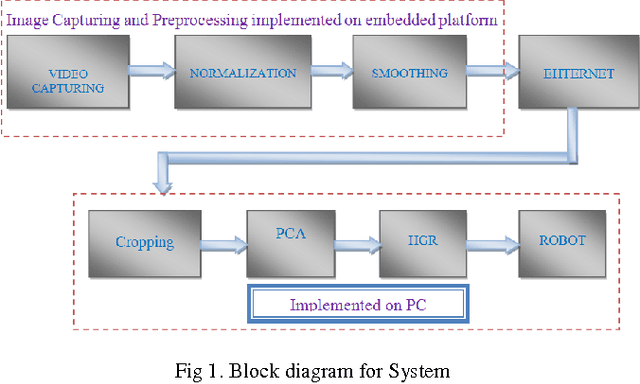
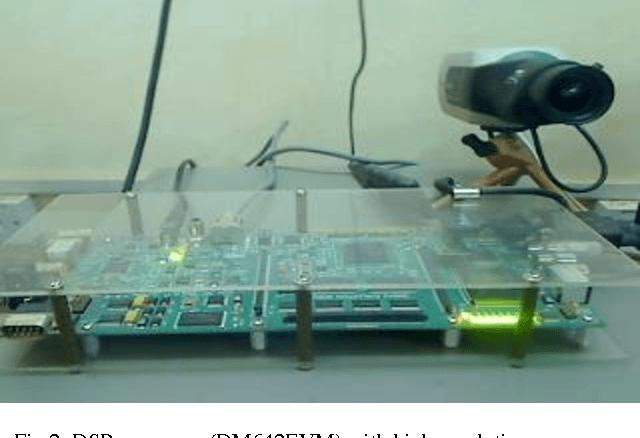
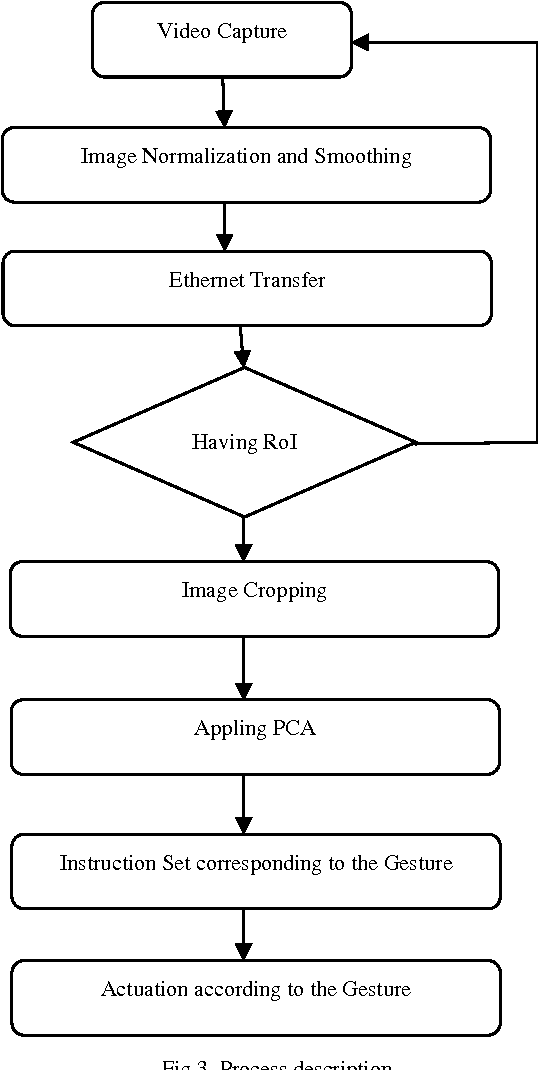
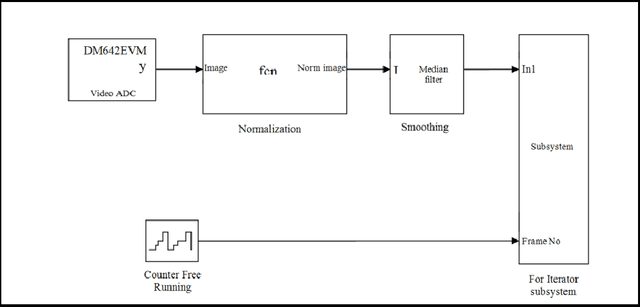
Abstract:Telepresence is a necessity for present time as we can't reach everywhere and also it is useful in saving human life at dangerous places. A robot, which could be controlled from a distant location, can solve these problems. This could be via communication waves or networking methods. Also controlling should be in real time and smooth so that it can actuate on every minor signal in an effective way. This paper discusses a method to control a robot over the network from a distant location. The robot was controlled by hand gestures which were captured by the live camera. A DSP board TMS320DM642EVM was used to implement image pre-processing and fastening the whole system. PCA was used for gesture classification and robot actuation was done according to predefined procedures. Classification information was sent over the network in the experiment. This method is robust and could be used to control any kind of robot over distance.
Real Time Fabric Defect Detection System on an Embedded DSP Platform
Sep 08, 2014



Abstract:In industrial fabric productions, automated real time systems are needed to find out the minor defects. It will save the cost by not transporting defected products and also would help in making compmay image of quality fabrics by sending out only undefected products. A real time fabric defect detection system (FDDS), implementd on an embedded DSP platform is presented here. Textural features of fabric image are extracted based on gray level co-occurrence matrix (GLCM). A sliding window technique is used for defect detection where window moves over the whole image computing a textural energy from the GLCM of the fabric image. The energy values are compared to a reference and the deviations beyond a threshold are reported as defects and also visually represented by a window. The implementation is carried out on a TI TMS320DM642 platform and programmed using code composer studio software. The real time output of this implementation was shown on a monitor.
Fingers' Angle Calculation using Level-Set Method
Jun 13, 2014
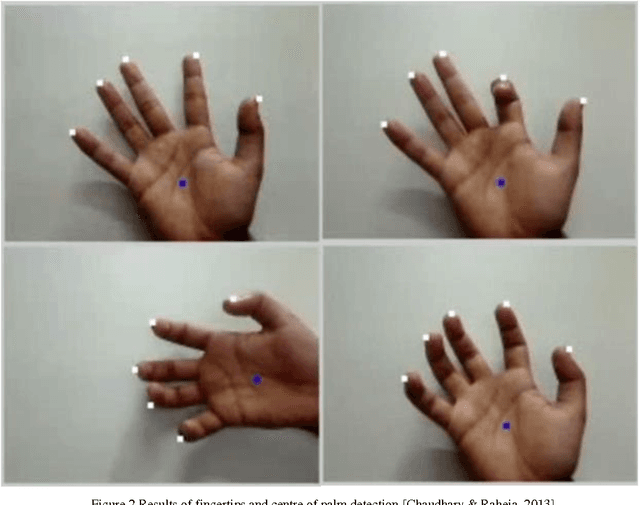


Abstract:In the current age, use of natural communication in human computer interaction is a known and well installed thought. Hand gesture recognition and gesture based applications has gained a significant amount of popularity amongst people all over the world. It has a number of applications ranging from security to entertainment. These applications generally are real time applications and need fast, accurate communication with machines. On the other end, gesture based communications have few limitations also like bent finger information is not provided in vision based techniques. In this paper, a novel method for fingertip detection and for angle calculation of both hands bent fingers is discussed. Angle calculation has been done before with sensor based gloves/devices. This study has been conducted in the context of natural computing for calculating angles without using any wired equipment, colors, marker or any device. The pre-processing and segmentation of the region of interest is performed in a HSV color space and a binary format respectively. Fingertips are detected using level-set method and angles were calculated using geometrical analysis. This technique requires no training for system to perform the task.
Automated Switching System for Skin Pixel Segmentation in Varied Lighting
Apr 17, 2013

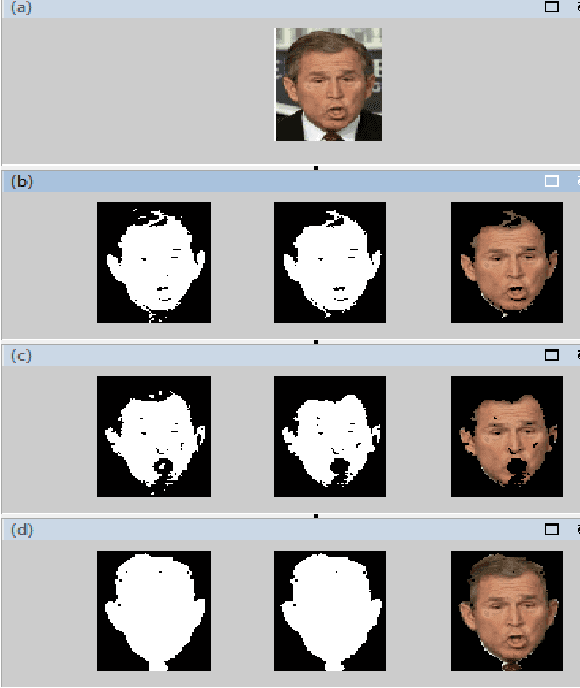
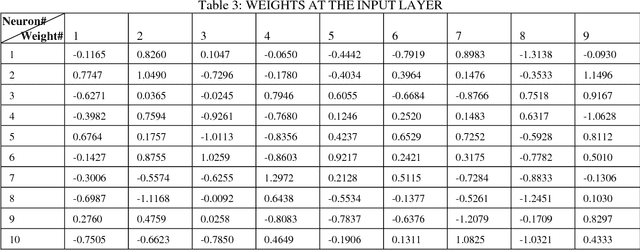
Abstract:In Computer Vision, colour-based spatial techniquesoften assume a static skin colour model. However, skin colour perceived by a camera can change when lighting changes. In common real environment multiple light sources impinge on the skin. Moreover, detection techniques may vary when the image under study is taken under different lighting condition than the one that was earlier under consideration. Therefore, for robust skin pixel detection, a dynamic skin colour model that can cope with the changes must be employed. This paper shows that skin pixel detection in a digital colour image can be significantly improved by employing automated colour space switching methods. In the root of the switching technique which is employed in this study, lies the statistical mean of value of the skin pixels in the image which in turn has been derived from the Value, measures as a third component of the HSV. The study is based on experimentations on a set of images where capture time conditions varying from highly illuminated to almost dark.
* 6 pages
A Health Monitoring System for Elder and Sick Persons
Apr 17, 2013



Abstract:This paper discusses a vision based health monitoring system which would be very easy in use and deployment. Elder and sick people who are not able to talk or walk they are dependent on other human beings for their daily needs and need continuous monitoring. The developed system provides facility to the sick or elder person to describe his or her need to their caretaker in lingual description by showing particular hand gesture with the developed system. This system uses fingertip detection technique for gesture extraction and artificial neural network for gesture classification and recognition. The system is able to work in different light conditions and can be connected to different devices to announce users need on a distant location.
A Hash based Approach for Secure Keyless Steganography in Lossless RGB Images
Apr 17, 2013



Abstract:This paper proposes an improved steganography approach for hiding text messages in lossless RGB images. The objective of this work is to increase the security level and to improve the storage capacity with compression techniques. The security level is increased by randomly distributing the text message over the entire image instead of clustering within specific image portions. Storage capacity is increased by utilizing all the color channels for storing information and providing the source text message compression. The degradation of the images can be minimized by changing only one least significant bit per color channel for hiding the message, incurring a very little change in the original image. Using steganography alone with simple LSB has a potential problem that the secret message is easily detectable from the histogram analysis method. To improve the security as well as the image embedding capacity indirectly, a compression based scheme is introduced. Various tests have been done to check the storage capacity and message distribution. These testes show the superiority of the proposed approach with respect to other existing approaches.
* The paper is withdrawn due to license issue
 Add to Chrome
Add to Chrome Add to Firefox
Add to Firefox Add to Edge
Add to Edge